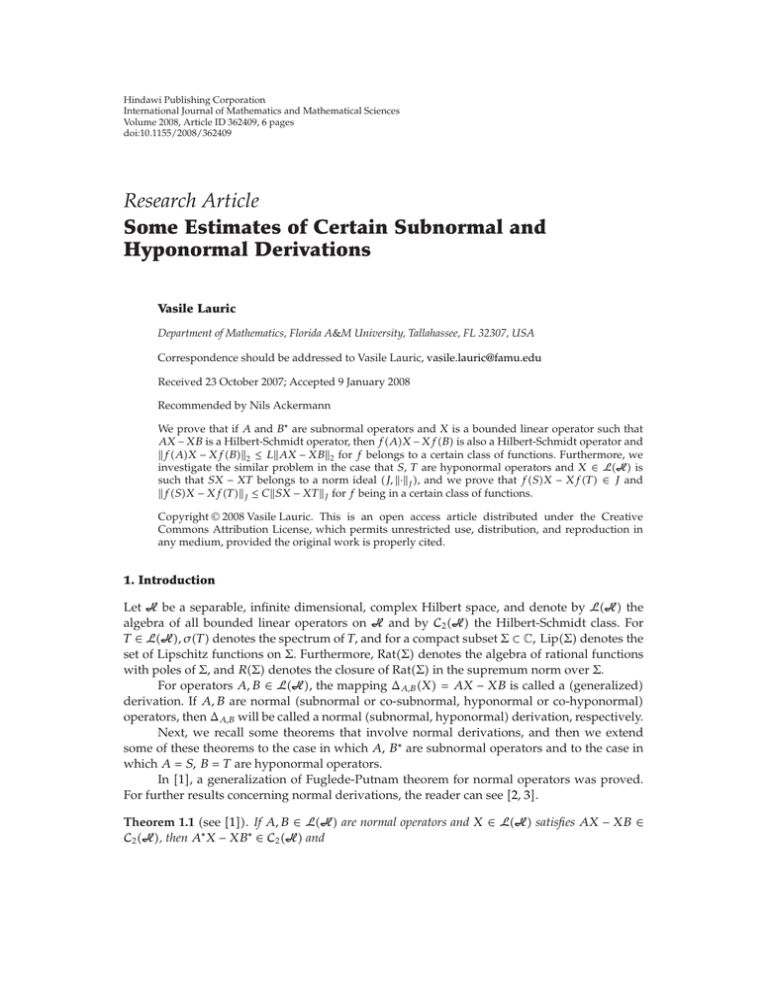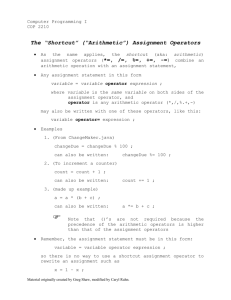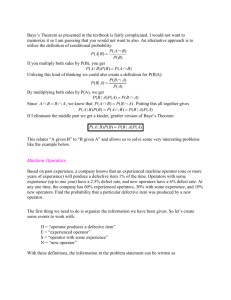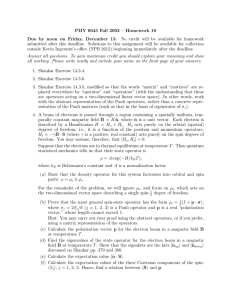Hindawi Publishing Corporation International Journal of Mathematics and Mathematical Sciences
advertisement

Hindawi Publishing Corporation
International Journal of Mathematics and Mathematical Sciences
Volume 2008, Article ID 362409, 6 pages
doi:10.1155/2008/362409
Research Article
Some Estimates of Certain Subnormal and
Hyponormal Derivations
Vasile Lauric
Department of Mathematics, Florida A&M University, Tallahassee, FL 32307, USA
Correspondence should be addressed to Vasile Lauric, vasile.lauric@famu.edu
Received 23 October 2007; Accepted 9 January 2008
Recommended by Nils Ackermann
We prove that if A and B∗ are subnormal operators and X is a bounded linear operator such that
AX − XB is a Hilbert-Schmidt operator, then fAX − XfB is also a Hilbert-Schmidt operator and
fAX − XfB2 ≤ LAX − XB2 for f belongs to a certain class of functions. Furthermore, we
investigate the similar problem in the case that S, T are hyponormal operators and X ∈ LH is
such that SX − XT belongs to a norm ideal J, ·J , and we prove that fSX − XfT ∈ J and
fSX − XfT J ≤ CSX − XT J for f being in a certain class of functions.
Copyright q 2008 Vasile Lauric. This is an open access article distributed under the Creative
Commons Attribution License, which permits unrestricted use, distribution, and reproduction in
any medium, provided the original work is properly cited.
1. Introduction
Let H be a separable, infinite dimensional, complex Hilbert space, and denote by LH the
algebra of all bounded linear operators on H and by C2 H the Hilbert-Schmidt class. For
T ∈ LH, σT denotes the spectrum of T, and for a compact subset Σ ⊂ C, LipΣ denotes the
set of Lipschitz functions on Σ. Furthermore, RatΣ denotes the algebra of rational functions
with poles of Σ, and RΣ denotes the closure of RatΣ in the supremum norm over Σ.
For operators A, B ∈ LH, the mapping ΔA,B X AX − XB is called a generalized
derivation. If A, B are normal subnormal or co-subnormal, hyponormal or co-hyponormal
operators, then ΔA,B will be called a normal subnormal, hyponormal derivation, respectively.
Next, we recall some theorems that involve normal derivations, and then we extend
some of these theorems to the case in which A, B ∗ are subnormal operators and to the case in
which A S, B T are hyponormal operators.
In 1, a generalization of Fuglede-Putnam theorem for normal operators was proved.
For further results concerning normal derivations, the reader can see 2, 3.
Theorem 1.1 see 1. If A, B ∈ LH are normal operators and X ∈ LH satisfies AX − XB ∈
C2 H, then A∗ X − XB ∗ ∈ C2 H and
2
International Journal of Mathematics and Mathematical Sciences
AX − XB2 A∗ X − XB ∗ 2 .
1.1
In 4, Furuta extended the above result to subnormal operators.
Theorem 1.2 see 4. If A, B ∗ ∈ LH are subnormal operators and X ∈ LH satisfies AX −XB ∈
C2 H, then A∗ X − XB ∗ ∈ C2 H and
AX − XB2 ≥ A∗ X − XB ∗ 2 .
1.2
In his paper 5, Kittaneh proved the following theorem using a famous result of
Voiculescu 6 according to which every normal operator can be written as the sum of a
diagonal operator and a Hilbert-Schmidt operator of an arbitrarily small Hilbert-Schmidt
norm.
Theorem 1.3 see 5. Let A, B ∈ LH be normal operators and X ∈ LH such that AX − XB ∈
C2 H, and let f ∈ LipσA ∪ σB. Then fAX − XfB is also a Hilbert-Schmidt operator and
fAX − XfB ≤ LAX − XB2 ,
2
1.3
where L is the Lipschitz constant of the function f.
2. Subnormal derivations
In this section, we investigate the validity of this inequality in the case that A, B ∗ are subnormal
operators, but with a drawback concerning the extent of the class of functions in which f can
run.
The following lemma is elementary and can be easily established making use of the
minimal normal extension of a subnormal operator. Its proof is left for the reader.
Lemma 2.1. If S1 , S2 ∈ LH are subnormal operators, then there exists a Hilbert space K ⊃ H and
normal operators N1 , N2 ∈ LK that are extensions of S1 , S2 , respectively, and σNi ⊆ σSi , i 1, 2
For a subnormal operator S ∈ LH and a function f ∈ RσS, one can associate an
operator fS ∈ LH as follows. Let rn ∈ RatσS, n ∈ N, such that
f − rn −→ 0,
σS,∞
as n −→ ∞,
2.1
and let NS ∈ LK, where K ⊃ H, be the minimal normal extension of S. Since σNS ⊆ σS,
we have
rn S S12
r n NS ,
2.2
0 S22
and rn NS → fNS in the operator norm of LK. Therefore, rn S converges in the operator
norm of LH to an operator that will be denoted by fS. It is obvious that this operator does
not depend on the sequence {rn }. In a similar way, for f ∈ RσT , one can define fT , when
T ∗ ∈ LH is a subnormal operator.
Vasile Lauric
3
Theorem 2.2. Let A, B ∗ ∈ LH be subnormal operators and X ∈ LH such that AX − XB ∈
C2 H, and let Σ σA ∪ σB and f ∈ LipΣ ∩ RΣ. Then fAX − XfB is also a HilbertSchmidt operator and
fAX − XfB ≤ LAX − XB2 ,
2
2.3
where L is the Lipschitz constant of the function f.
Proof. For subnormal operators A, B ∗ ∈ LH, according to Lemma 2.1, there exists a Hilbert
space K ⊃ H and there are some normal operators NA , NB∗ ∈ LK such that relative to the
decomposition of K H ⊕ H⊥ , we have
NA A A12
0 A22
NB ∗ ,
∗
B B12
0 B22
2.4
,
and σNA ⊆ σA, σNB∗ ⊆ σB ∗ .
X ⊕ 0 on H ⊕ H⊥ , then we have NA X
− XN
∗ ∗ AX − XB ⊕ 0, and
If we put X
B
− XN
∗ ∗ ∈ C2 K.
therefore NA X
B
For r ∈ RatΣ, where Σ σA ∪ σB, a simple calculation shows that
r NA rA A12
0
A22
,
r NB∗ ∗ rB 0
B22
B21
.
2.5
Thus, if f ∈ LipΣ ∩ RΣ, using a limiting argument, one can see that fNA and fNB∗ ∗ have
similar matrix representation as in 2.5, but with f replacing r. According to Theorem 1.3,
− Xf
N ∗ ∗ ∈ C2 K,
f NA X
B
f NA X
− XN
∗∗ .
− Xf
N ∗ ∗ ≤ LNA X
B
B 2
2
2.6
∗
− XfN
Since fNA X
B ∗ fAX − XfB ⊕ 0, the proof is finished.
Corollary 2.3. Let A, B ∗ ∈ LH be subnormal operators and X ∈ LH such that AX − XB ∈
C2 H, and let Σ σA ∪ σB and f ∈ LipΣ ∩ RΣ. Then
fA∗ X − XfB∗ ≤ fAX − XfB ,
2
2
2.7
||fA∗ X − XfB∗ ||2 ≤ L||AX − XB||2 ,
2.8
and thus
where L is the Lipschitz constant of the function f.
Proof. The first inequality is a consequence of Theorem 1.2 after observing that fA and fB∗
are subnormal operators. The second inequality follows from Theorem 2.2.
4
International Journal of Mathematics and Mathematical Sciences
3. Hyponormal derivations
In this section, we approach the same problem, but in the case in which A S, B T are
hyponormal operators and the Hilbert-Schmidt class is replaced with an arbitrary norm ideal.
For a hyponormal operator T ∈ LH, the analytic functional calculus can be extended to
a class Aα σT of “pseudo-analytic” functions on σT that satisfy a certain growth condition
at the boundary.
The extension of the analytic functional calculus for a hyponormal operator was
introduced by Dyn’kin cf. 7, 8 and it also can be found in 9.
We briefly review the definition and the main tools that are necessary. Let Σ be a perfect
compact set of the complex plane and let α be a positive noninteger with k its integer part, α.
The class Aα Σ is defined as the set of k 1 tuples of continuous functions on Σ, f0 , . . . , fk :
Σ → Ck1 that are related by
fk z 0 fj1 z0 k−j
fj z fj z0 Rj z 0 , z ,
z − z0 · · · z − z0
1!
k − j!
Rj z0 , z ≤ Cj z − z0 α−j
3.1
for j 0, . . . , k and z, z0 ∈ Σ. Since Σ is a perfect set,
fj−1 z − fj−1 z0
,
fj z0 lim
z→z0
z − z0
j 0, . . . , k − 1,
3.2
and thus the k 1 tuple depends only on f0 . The space Aα Σ, endowed with the maximum of
the smallest constants that satisfy 3.1 plus the supremum norm on Σ of f0 , becomes a unital
Banach algebra and is a closed subalgebra of Lipα, Σ, the algebra of Lipschitz functions of
order α.
Theorem 3.1 see 8. Let Σ be a perfect compact set, f ∈ CΣ, and α a positive noninteger. The
following are equivalent:
a f ∈ Aα Σ;
b f has an extension F ∈ C1 C \ Σ with |∂Fz| ≤ C · distz, Σα−1 , z /
∈ Σ;
c there exists φ ∈ C0 C such that
fz φw
dμw,
w−z
z ∈ Σ,
3.3
and |φw| ≤ C0 · fAα Σ · distw, Σα−1 , w ∈ C, where μ is planar Lebesgue measure and
C0 is a constant that does not depend on f.
If T ∈ LH is a hyponormal operator, then ||T || ||T ||σ , where ||T ||σ denotes the
spectral radius of T, that is supz∈σT |z|. It is well known that if z /
∈ σT , then z − T −1 is also
hyponormal and thus
z − T −1 1
.
dist z, σT 3.4
Vasile Lauric
5
Thus, for a hyponormal operator T whose spectrum σT is a perfect set and for a function
f ∈ Aα σT with α > 2, one can associate an operator defined by
φww − T −1 dμw
3.5
that will be denoted by fT . The above integral does not depend on φ, that is, the definition
of fT is not ambiguous, and the mapping φ → fT acting from Aα σT into LH is
a continuous, unital morphism of Banach algebras, and which extends the Riesz-Dunford
calculus.
Let J, || · ||J be a norm ideal, that is, a proper two-sided ideal J of LH with a norm
|| · ||J that satisfies th following: J, || · ||J is a Banach space and AXBJ ≤ ABXJ , for
all X ∈ J and any A, B ∈ LH. In particular, the Shatten-von Neumann p-classes, Cp H, for
p ≥ 1, are instances of norm ideals.
Theorem 3.2. Let J, || · ||J be a norm ideal, let S, T ∈ LH be hyponormal operators for which both
σS and σT are perfect sets, let f belong to Aα Σ with α > 3 and Σ σS ∪ σT , and let
X ∈ LH such that SX − XT ∈ J. Then fSX − XfT ∈ J and
||fSX − XfT ||J ≤ C1 · ||f||Aα Σ · ||SX − XT ||J ,
3.6
where C1 is a constant that depends on Σ but it does not depend on f.
Proof. For f ∈ Aα Σ, according to Theorem 3.1, there exists φ ∈ C0 C such that
φw
fz dμw, z ∈ Σ,
w−z
φw ≤ C0 · fAα Σ · distw, Σα−1 ,
Therefore,
fSX − XfT 3.7
w ∈ C.
φw w − S−1 X − Xw − T −1 dμw.
3.8
The domain of integration is suppφ, which is a compact set that has in common with Σ only
possibly boundary points of Σ. For w ∈ suppφ ∩ C \ Σ,
w − S−1 X − Xw − T −1 w − S−1 Xw − T − w − SX w − T −1
3.9
w − S−1 SX − XT w − T −1 ∈ J,
and, according to 3.4,
w − S−1 X − Xw − T −1 ≤ dist w, σS −1 · dist w, σT −1 · SX − XT J
J
≤ C · distw, Σ−2 · SX − XT J ,
3.10
where C is a constant that depends on Σ. Therefore, the integrant in 3.8 belongs to the norm
ideal J and
φww − S−1 X − Xw − T −1 ≤ C0 · C · fAα Σ · distw, Σα−3 SX − XT J ,
3.11
J
6
International Journal of Mathematics and Mathematical Sciences
for w ∈ suppφ ∩ C \ Σ. After integration one obtains the desired conclusion of the theorem.
References
1 G. Weiss, “The Fuglede commutativity theorem modulo the Hilbert-Schmidt class and generating
functions for matrix operators. II,” Journal of Operator Theory, vol. 5, no. 1, pp. 3–16, 1981.
2 G. Weiss, “The Fuglede commutativity theorem modulo operator ideals,” Proceedings of the American
Mathematical Society, vol. 83, no. 1, pp. 113–118, 1981.
3 G. Weiss, “An extension of the Fuglede commutativity theorem modulo the Hilbert-Schmidt class to
operators of the form ΣMn XNn ,” Transactions of the American Mathematical Society, vol. 278, no. 1, pp.
1–20, 1983.
4 T. Furuta, “An extension of the Fuglede-Putnam theorem to subnormal operators using a HilbertSchmidt norm inequality,” Proceedings of the American Mathematical Society, vol. 81, no. 2, pp. 240–242,
1981.
5 F. Kittaneh, “On Lipschitz functions of normal operators,” Proceedings of the American Mathematical
Society, vol. 94, no. 3, pp. 416–418, 1985.
6 D. Voiculescu, “Some results on norm-ideal perturbations of Hilbert space operators,” Journal of
Operator Theory, vol. 2, no. 1, pp. 3–37, 1979.
7 E. M. Dyn’kin, “An operator calculus based on the Cauchy-Green formula. Investigations on linear
operators and the theory of functions, III,” Zapiski Naučnyh Seminarov Leningradskogo Otdelenija
Matematičeskogo Instituta im. V. A. Steklova Akademii Nauk SSSR (LOMI), vol. 30, pp. 33–39, 1972,
Russian.
8 E. M. Dyn’kin, “Pseudoanalytic continuation of smooth functions. Uniform scale,” in Mathematical
Programming and Related Questions (Proc. Seventh Winter School, Drogobych, 1974), Theory of Functions
and Functional Analysis (Russian), pp. 40–73, Central Èkonom.-Mat. Inst. Akad. Nauk SSSR, Moscow,
Russia, 1976.
9 M. Martin and M. Putinar, Lectures on Hyponormal Operators, vol. 39 of Operator Theory: Advances and
Applications, Birkhäuser, Basel, Switzerland, 1989.





